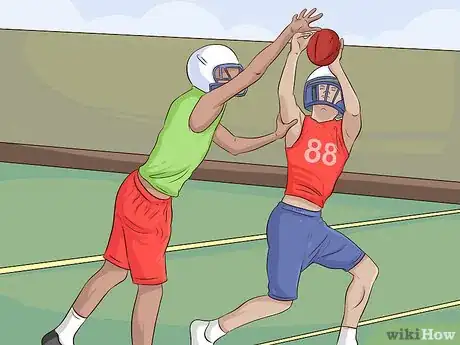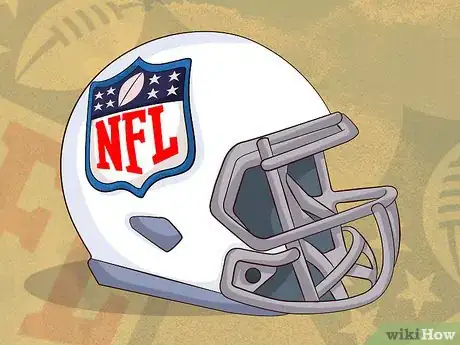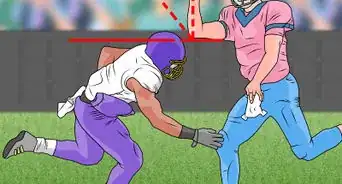This article was co-authored by wikiHow Staff. Our trained team of editors and researchers validate articles for accuracy and comprehensiveness. wikiHow's Content Management Team carefully monitors the work from our editorial staff to ensure that each article is backed by trusted research and meets our high quality standards.
There are 11 references cited in this article, which can be found at the bottom of the page.
wikiHow marks an article as reader-approved once it receives enough positive feedback. This article received 21 testimonials and 85% of readers who voted found it helpful, earning it our reader-approved status.
This article has been viewed 620,267 times.
Learn more...
If playing for the NFL is your dream, your best bet is to work hard and market yourself as a strong player. Start training in or before high school so you can gain both experience and exposure. Once you get to college, your next step is to train for the NFL draft. Knowing what to do and how to qualify will increase your chances of becoming a professional football player.
Steps
Qualifying for College Football
-
1Join your high school football team. Playing on your high school football team will increase your experience and your exposure. College football coaches (and NFL recruiters) are more likely to take note if you do well in high school football. Recruiting can start as early as freshman or sophomore year, so try out as early as possible.[1]
- If your high school does not have a football team, transfer to one that does or join a club team. High school teams are highly preferable.
- Getting your high school diploma is a requirement for playing on the NFL, so study hard and plan to graduate.[2]
-
2Gain exposure at a university football camp. Sports camps are a great way to connect with and get noticed by university coaches. A coach may be more likely to remember your name if you spend time training with them at sports camps. Spend time with the players and get your name out there: think of your football camp experience as early networking. This is your chance to make a first impression.Advertisement
-
3Make a list of ideal colleges with your coach. Tell your football coach you want to apply for college football so they can support you however possible. When making your list, separate it into three sections: list your dream schools, schools you could realistically plan for, and schools to fall back on.
- Ask your coach to be honest with you about your skill set so you can make a helpful list.
- Once you have a list of schools, research them. Check out the school's athletic website and read up on current and former players, as well as their recruiting process.
-
4Create a highlight video. Recruiting videos are important for catching the attention of college coaches. Compile a play-by-play video of your best in-game moments. Make sure each play highlights your athletic ability.[3]
- Quality matters. Record your highlight video on a good camera, and consider hiring a professional videographer.
- If you're on a budget and must tape it yourself, use a tripod to avoid camera shake.[4]
-
5Register with the NCAA by your junior year. If you want to play college football at a Division I or II school, you need to register with the NCAA Eligibility Center to validate your status as an amateur athlete. Ask your football coach to assist you in registering so you remember to pay any fees and submit required documents.
- Because qualified players will need to complete academic work at an American college or university, the NCAA application is currently only available in English.
-
6Contact potential college coaches by your junior year. Junior year is the time to make yourself and your abilities known by the college coaches. Write an email or letter to university coaches you're interested in playing for. Send a copy (or a link) of your highlights video along with a resume with details like your stats, academic data, honors, and your coach's contact information.
- You can also call the university coaches so you can personally get to know them. Avoid having your parents call potential universities, as this is considered unprofessional.
-
7Choose an offer during your senior year. By your senior year, university coaches should contact you about potential offers. Decide which offer is in your best interests. What scholarships are these colleges offering? Are the potential schools a Division I or II school?
- Division I schools have the largest athletic budgets and travel nationally to play. Division II schools have less budget money and usually travel regionally.[5]
- Anyone is allowed to enter the NFL draft, as long as they have graduated high school. If you don't play in college, continue training hard and consider becoming a walk-on.[6]
Training in College
-
1Become a walk-on if you are not chosen for a team. College walk-ons are players who either didn't receive an offer in high school or wants to attend a college that does not offer scholarships (like Ivy League universities). Stick your foot in the door with college coaches and ask them how to qualify for a walk-on position. If you have athletic skill, the coach may give you a shot.[7]
- Most college walk-ons do not receive an athletic scholarship.
- Qualified walk-ons need to build good character, strong academics, and a thick skin.[8]
-
2Create a training schedule, and practice every day. If you make it on your college team, you will have assigned practices almost every day. But if you're training for the draft on your own, you'll need to develop diligence on your own. Plan a fitness schedule that keeps your body in shape and pushes you to your physical limits.
- Rest days are just as necessary as training days. Work in one day of light activity (like walking or yoga) per week to avoid overexertion.
-
3Work on movement mechanics. When training, work on your running, jumping, and direction-changing skills. During the NFL draft, you will need to compete in a 40-yard dash. Practice your agility through aerobic exercises, like sprinting, kickboxing, and using cardio machines.
-
4Practice strength training. Strength training will give you the endurance and power you need to stand out in the NFL draft. Strengthen your core through bench press exercises, squats, and deadlifts. Maintain a good balance of aerobic and anaerobic exercises to give your body optimum balance.[9]
-
5Know and improve on your weaknesses. Understand your body's deficiencies and focus on them when you're working out. Ask your coach or mentor about where you could improve your skill. Tell them to be honest with you so you have every opportunity to improve before the draft.
- For example, if your upper-body strength overpowers your leg strength, focus on lower-body exercises to balance yourself.
Entering the Draft
-
1Play college football for several years before applying for the draft. The NFL states that prospective draftees must have graduated high school at least three years before performing in the draft. Use your college football time to build an athletic resume and catch the eyes of NFL coaches.[10]
- If you do not play college football, register for the draft around your senior year of college.
- After you graduate college, your draft eligibility is only good for the year after you graduated (or if four football seasons have passed since you graduated high school).
-
2Declare for the NFL Regional Combine. Once you are three years past your high school days, register for the draft. You will begin by registering for the Regional Starting Combines, where you will try out among college football players and other individual trainees. Although anyone can apply, the NFL requests that only those with a high level of ability register.
- If you catch a scout's eye during the athletic drills and measurements, you may be invited to try out at the National Combine.
-
3Attend the NFL National Combine. Unlike regionals, only about 335 players are invited to try out at nationals every year. This is a chance for you to measure yourself against the best of the best in drills like the 40-yard dash, bench press, and vertical leap. From here, about 250 athletes will make it to the NFL draft.[11]
- After your physical evaluation, you will also undergo medical examinations to gage your physical, mental, and emotional health.
-
4Enter the NFL draft. During the draft, football scouts will measure you against other players in extensive medical and physical evaluations. The draft consists of seven rounds, with professional football teams picking their new players. During the draft, you can also network with personnel and negotiate for a spot on a team's training roster.
-
5Apply for the supplemental draft in July, if you do not earn a spot. The supplemental draft is for those whose eligibility has changed since the draft. Teams can make bids on players, and the team with the highest bid is awarded the player. Professional teams do not have to attend the supplemental drafts, but you never know which coaches and scouts might attend.[12]
- If you still don't qualify for the NFL, all is not lost. The NFL Transition Assistance Program provides college players with support while they transition to a life beyond football.
Community Q&A
-
QuestionWhat if I don't get drafted and don't know how else to become an NFL player?
 Community AnswerThe NFL also has five regional combines, located in Houston, Arizona, Baltimore, Minnesota and New Orleans. You could try out at one of them and may even receive a free agent offer directly afterward.
Community AnswerThe NFL also has five regional combines, located in Houston, Arizona, Baltimore, Minnesota and New Orleans. You could try out at one of them and may even receive a free agent offer directly afterward. -
QuestionHow do you become a NFL player?
 Community AnswerStart by being in college football and be a good player. In the high school football team, the NFL coaches are watching already, so they can decide whether you're ideal for the team after your college years.
Community AnswerStart by being in college football and be a good player. In the high school football team, the NFL coaches are watching already, so they can decide whether you're ideal for the team after your college years. -
QuestionCan an NFL team contact a college player directly and hire that player without the player going through the draft?
 DonaganTop AnswererNo. The draft system was instituted to avoid the chaos that would occur if NFL teams tried to recruit players directly. The draft also promotes parity among the teams.
DonaganTop AnswererNo. The draft system was instituted to avoid the chaos that would occur if NFL teams tried to recruit players directly. The draft also promotes parity among the teams.
References
- ↑ http://www.athleticscholarships.net/footballscholarships.htm
- ↑ http://profootballtalk.nbcsports.com/2013/03/04/anyone-yes-anyone-can-try-out-for-the-nfl/
- ↑ https://www.sbnation.com/college-football-recruiting/2013/2/20/4009796/college-football-recruit-highlight-tape
- ↑ http://www.ncsasports.org/recruiting-tools/college-football-recruiting/football-highlight-video
- ↑ http://blog.prepscholar.com/what-are-ncaa-divisions-1-vs-2-vs-3
- ↑ http://www.ncsasports.org/recruiting-tools/college-football-recruiting/football-highlight-video
- ↑ http://www.collegesportsscholarships.com/team-walk-on-tryout.htm
- ↑ http://www.stack.com/a/how-to-become-a-college-walk-on
- ↑ http://thesportdigest.com/archive/article/case-combined-training
About This Article
If you think you want to play in the NFL, start playing football in high school, and go to university football camps to get noticed by university coaches. If you think you have a chance, register with the NCAA as an amateur athlete before your junior year. Once you graduate high school, play at least 3 years of college football to gain experience. Then, enter in the NFL regional Combine, then National Combine, and finally enter the draft. Keep reading to see what skills you should be developing during this time!





























-Step-8.webp)

















































